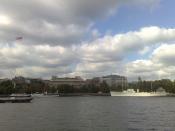QANTAS DISPUTE
On October 22nd, 2001, the Industrial dispute between QANTAS and its employees was initiated with the offering of a new Enterprise Bargaining Agreement. This proposed an 18-month wage freeze for employees plus a sliding scale profit share scheme. Ten out of twelve unions under QANTAS accepted the terms of the agreement, barring the unions of manufacturing employees (AWU and AMWU). They were holding out for a 4-6% pay rise. On the 8th May 2002, some ten months later, the dispute was resolved when QANTAS agreed to an across the board 6% pay increase. This essay provides an in-depth analysis into the dispute, including causes, the resolution process, the role of stakeholders, and costs and benefits for all concerned.
The industrial dispute occurred primarily because of two reasons, wage demands, and management policy. In both areas of conflict, there was contradiction between the aims of QANTAS management and manufacturing employees.
The wage demands occurred as a conflict between two major stakeholders, employees and employers, as established in both plural and radical views on conflict. QANTAS proposed that all employees accept an 18-month wage freeze, in order to obtain bonus levels if profit margins reach certain targets. They believed that this was in their best interests as the business had the goal of minimising costs in order to maintain international competitiveness. Competitors were entering the market with lower cost structures, which QANTAS could not match, so they had to reduce costs, which in this case was wages. They justified their cause with the fact that 83% of Unions accepted this. The manufacturing employees, on the other hand, wanted to maximise their wages. In this case, they wished only to maintain wage levels, demanding a 4 to 6% increase in wage levels in order to match the increase in cost...


